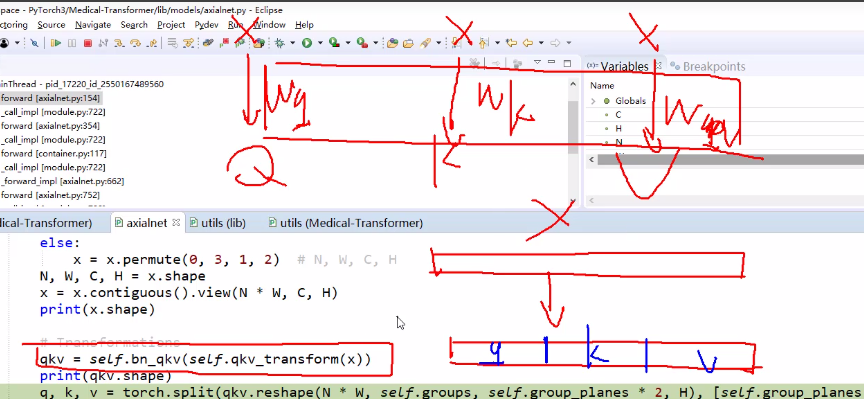1.数据预处理
数据预处理部分比较常规,进行了一下裁剪和色彩增强操作,比较简单,不在多说。另外,官方github上提供了数据
2.网络结构
全局特征提取
首先,为了节省运算,经过卷积对特征图进行下采样,下采样至64*64大小,然后将结果输入堆叠的Gate Aixal Attention中,进行特征提取。
Gate Aixal Attention:
Aixal Attention分别对H轴和W轴进行自注意力机制运算,具体过程为:
- 首先经过线性投影得到q,k,v,需要注意的是q为8个通道,k为8个通道,v为16个通道,因为v要汇集两个轴的信息。
- 随机初始化可以学习的位置编码r,维度为4,H,W,其中q的维度为1,H,W,K的维度为1,H,W,V的维度为2,H,W
- 如下图所示,首先求得qk,qr,kr,并对qr和kr使用Gk,Gq抑制因子对qr和kr的影响进行抑制。然后汇集qk和qr、kr的信息,具体为先拼接再求和,最后经过softmax归一化得到注意力权重
- 求得qkv和qkr,并使用门控抑制因子进行抑制,然后融合特征和位置编码(先拼接再求和)得到注意力计算结果


局部特征提取:
对于局部特征提取,与全局特征提取相类似,首先将特征图划分为16个小区域,经过卷积进行下采样, 然后将特征图输入轴注意力中,不同的是,此时的轴注意力没有相对位置编码,因为全局特征已经加入了位置编码,做完所有的Ecoder层以后,经过由卷积层和上采样层组成decoder(与u-net类似)。特征图不断增大。经过decoder后,合并所有的局部特征层,与全局特征提取结果进行拼接,输出结果。
代码如下:
# madical transformer网络结构
class medt_net(nn.Module):
def __init__(self, block, block_2, layers, num_classes=2, zero_init_residual=True,
groups=8, width_per_group=64, replace_stride_with_dilation=None,
norm_layer=None, s=0.125, img_size = 128,imgchan = 3):
super(medt_net, self).__init__()
if norm_layer is None:
norm_layer = nn.BatchNorm2d
self._norm_layer = norm_layer
self.inplanes = int(64 * s)
self.dilation = 1
if replace_stride_with_dilation is None:
replace_stride_with_dilation = [False, False, False]
if len(replace_stride_with_dilation) != 3:
raise ValueError("replace_stride_with_dilation should be None "
"or a 3-element tuple, got {}".format(replace_stride_with_dilation))
self.groups = groups
self.base_width = width_per_group
self.conv1 = nn.Conv2d(imgchan, self.inplanes, kernel_size=7, stride=2, padding=3,
bias=False)
self.conv2 = nn.Conv2d(self.inplanes, 128, kernel_size=3, stride=1, padding=1, bias=False)
self.conv3 = nn.Conv2d(128, self.inplanes, kernel_size=3, stride=1, padding=1, bias=False)
self.bn1 = norm_layer(self.inplanes)
self.bn2 = norm_layer(128)
self.bn3 = norm_layer(self.inplanes)
# self.conv1 = nn.Conv2d(1, self.inplanes, kernel_size=3, stride=1, padding=1, bias=False)
self.bn1 = norm_layer(self.inplanes)
self.relu = nn.ReLU(inplace=True)
# self.maxpool = nn.MaxPool2d(kernel_size=3, stride=2, padding=1)
self.layer1 = self._make_layer(block, int(128 * s), layers[0], kernel_size= (img_size//2))
self.layer2 = self._make_layer(block, int(256 * s), layers[1], stride=2, kernel_size=(img_size//2),
dilate=replace_stride_with_dilation[0])
# self.layer3 = self._make_layer(block, int(512 * s), layers[2], stride=2, kernel_size=(img_size//4),
# dilate=replace_stride_with_dilation[1])
# self.layer4 = self._make_layer(block, int(1024 * s), layers[3], stride=2, kernel_size=(img_size//8),
# dilate=replace_stride_with_dilation[2])
# Decoder
# self.decoder1 = nn.Conv2d(int(1024 *2*s) , int(1024*2*s), kernel_size=3, stride=2, padding=1)
# self.decoder2 = nn.Conv2d(int(1024 *2*s) , int(1024*s), kernel_size=3, stride=1, padding=1)
# self.decoder3 = nn.Conv2d(int(1024*s), int(512*s), kernel_size=3, stride=1, padding=1)
self.decoder4 = nn.Conv2d(int(512*s) , int(256*s), kernel_size=3, stride=1, padding=1)
self.decoder5 = nn.Conv2d(int(256*s) , int(128*s) , kernel_size=3, stride=1, padding=1)
self.adjust = nn.Conv2d(int(128*s) , num_classes, kernel_size=1, stride=1, padding=0)
self.soft = nn.Softmax(dim=1)
self.conv1_p = nn.Conv2d(imgchan, self.inplanes, kernel_size=7, stride=2, padding=3,
bias=False)
self.conv2_p = nn.Conv2d(self.inplanes,128, kernel_size=3, stride=1, padding=1,
bias=False)
self.conv3_p = nn.Conv2d(128, self.inplanes, kernel_size=3, stride=1, padding=1,
bias=False)
# self.conv1 = nn.Conv2d(1, self.inplanes, kernel_size=3, stride=1, padding=1, bias=False)
self.bn1_p = norm_layer(self.inplanes)
self.bn2_p = norm_layer(128)
self.bn3_p = norm_layer(self.inplanes)
self.relu_p = nn.ReLU(inplace=True)
img_size_p = img_size // 4
self.layer1_p = self._make_layer(block_2, int(128 * s), layers[0], kernel_size= (img_size_p//2))
self.layer2_p = self._make_layer(block_2, int(256 * s), layers[1], stride=2, kernel_size=(img_size_p//2),
dilate=replace_stride_with_dilation[0])
self.layer3_p = self._make_layer(block_2, int(512 * s), layers[2], stride=2, kernel_size=(img_size_p//4),
dilate=replace_stride_with_dilation[1])
self.layer4_p = self._make_layer(block_2, int(1024 * s), layers[3], stride=2, kernel_size=(img_size_p//8),
dilate=replace_stride_with_dilation[2])
# Decoder
self.decoder1_p = nn.Conv2d(int(1024 *2*s) , int(1024*2*s), kernel_size=3, stride=2, padding=1)
self.decoder2_p = nn.Conv2d(int(1024 *2*s) , int(1024*s), kernel_size=3, stride=1, padding=1)
self.decoder3_p = nn.Conv2d(int(1024*s), int(512*s), kernel_size=3, stride=1, padding=1)
self.decoder4_p = nn.Conv2d(int(512*s) , int(256*s), kernel_size=3, stride=1, padding=1)
self.decoder5_p = nn.Conv2d(int(256*s) , int(128*s) , kernel_size=3, stride=1, padding=1)
self.decoderf = nn.Conv2d(int(128*s) , int(128*s) , kernel_size=3, stride=1, padding=1)
self.adjust_p = nn.Conv2d(int(128*s) , num_classes, kernel_size=1, stride=1, padding=0)
self.soft_p = nn.Softmax(dim=1)
def _make_layer(self, block, planes, blocks, kernel_size=56, stride=1, dilate=False):
norm_layer = self._norm_layer
downsample = None
previous_dilation = self.dilation
if dilate:
self.dilation *= stride
stride = 1
if stride != 1 or self.inplanes != planes * block.expansion:
downsample = nn.Sequential(
conv1x1(self.inplanes, planes * block.expansion, stride),
norm_layer(planes * block.expansion),
)
layers = []
layers.append(block(self.inplanes, planes, stride, downsample, groups=self.groups,
base_width=self.base_width, dilation=previous_dilation,
norm_layer=norm_layer, kernel_size=kernel_size))
self.inplanes = planes * block.expansion
if stride != 1:
kernel_size = kernel_size // 2
for _ in range(1, blocks):
layers.append(block(self.inplanes, planes, groups=self.groups,
base_width=self.base_width, dilation=self.dilation,
norm_layer=norm_layer, kernel_size=kernel_size))
return nn.Sequential(*layers)
def _forward_impl(self, x):
# 首先,经过卷积对特征图进行下采样,减少运算量
xin = x.clone()
x = self.conv1(x)
x = self.bn1(x)
x = self.relu(x)
x = self.conv2(x)
x = self.bn2(x)
x = self.relu(x)
x = self.conv3(x)
x = self.bn3(x)
# x = F.max_pool2d(x,2,2)
x = self.relu(x)
# x = self.maxpool(x)
# pdb.set_trace()
x1 = self.layer1(x)
print(x1.shape)
# print(x1.shape)
x2 = self.layer2(x1)
print(x2.shape)
# print(x2.shape)
# x3 = self.layer3(x2)
# # print(x3.shape)
# x4 = self.layer4(x3)
# # print(x4.shape)
# x = F.relu(F.interpolate(self.decoder1(x4), scale_factor=(2,2), mode ='bilinear'))
# x = torch.add(x, x4)
# x = F.relu(F.interpolate(self.decoder2(x4) , scale_factor=(2,2), mode ='bilinear'))
# x = torch.add(x, x3)
# x = F.relu(F.interpolate(self.decoder3(x3) , scale_factor=(2,2), mode ='bilinear'))
# x = torch.add(x, x2)
x = F.relu(F.interpolate(self.decoder4(x2) , scale_factor=(2,2), mode ='bilinear'))
x = torch.add(x, x1)
x = F.relu(F.interpolate(self.decoder5(x) , scale_factor=(2,2), mode ='bilinear'))
# print(x.shape)
# end of full image training
# y_out = torch.ones((1,2,128,128))
x_loc = x.clone()
print(x_loc.shape)
# x = F.relu(F.interpolate(self.decoder5(x) , scale_factor=(2,2), mode ='bilinear'))
#start
for i in range(0,4):
for j in range(0,4):
# 按照索引,划分为16个模块
x_p = xin[:,:,32*i:32*(i+1),32*j:32*(j+1)]
# begin patch wise 首先经过卷积进行下采样
x_p = self.conv1_p(x_p)
x_p = self.bn1_p(x_p)
# x = F.max_pool2d(x,2,2)
x_p = self.relu(x_p)
x_p = self.conv2_p(x_p)
x_p = self.bn2_p(x_p)
# x = F.max_pool2d(x,2,2)
x_p = self.relu(x_p)
x_p = self.conv3_p(x_p)
print(x_p.shape)
x_p = self.bn3_p(x_p)
# x = F.max_pool2d(x,2,2)
x_p = self.relu(x_p)
# x = self.maxpool(x)
# pdb.set_trace()
# 去除相对位置编码的轴注意力
x1_p = self.layer1_p(x_p)
# print(x1.shape)
x2_p = self.layer2_p(x1_p)
x3_p = self.layer3_p(x2_p)
x4_p = self.layer4_p(x3_p)
# Decoder,由卷积组成,并上采样
x_p = F.relu(F.interpolate(self.decoder1_p(x4_p), scale_factor=(2,2), mode ='bilinear'))
print(x_p.shape)
x_p = torch.add(x_p, x4_p)
print(x_p.shape)
x_p = F.relu(F.interpolate(self.decoder2_p(x_p) , scale_factor=(2,2), mode ='bilinear'))
print(x_p.shape)
x_p = torch.add(x_p, x3_p)
print(x_p.shape)
x_p = F.relu(F.interpolate(self.decoder3_p(x_p) , scale_factor=(2,2), mode ='bilinear'))
x_p = torch.add(x_p, x2_p)
x_p = F.relu(F.interpolate(self.decoder4_p(x_p) , scale_factor=(2,2), mode ='bilinear'))
x_p = torch.add(x_p, x1_p)
x_p = F.relu(F.interpolate(self.decoder5_p(x_p) , scale_factor=(2,2), mode ='bilinear'))
print(x_p.shape)
# 合并局部特征图
x_loc[:,:,32*i:32*(i+1),32*j:32*(j+1)] = x_p
x = torch.add(x,x_loc)
x = F.relu(self.decoderf(x))
x = self.adjust(F.relu(x))
# pdb.set_trace()
return x
def forward(self, x):
return self._forward_impl(x)